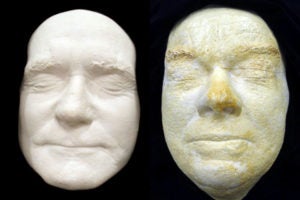From ghostly figures in the Law library to terrifying super webs of spiders, this research proves that reality can be spookier than fiction.
Hidden Ghosts in the Law Library


If you are working late at night in the Tarlton Law Library, you might notice the eerie glow of faces staring at you and hands looming in the dark. These “law school ghosts” are two of modern history’s most notable executioners – Albert Pierrepoint and Syd Dernley. They hung hundreds of criminals during the mid-20th century. Their hands and faces are preserved in plaster as a reminder of the history of the death penalty. The exhibit is part of the Hyder Collection, given to the UT Law School Foundation in 2011. The collection of art and artifacts represent the historical development of law and the growth of the rule of law throughout the world.
Spider Megawebs Are the Stuff of Nightmares
Running into one spider’s web would send chills down most people’s spines, but imagine turning the corner and walking into a giant spider web a quarter of a mile long. This phenomenon is called a “megaweb.” Many spiders are solitary creatures, but when the opportunity arises, they can come together. These rare events typically arise in Texas after very heavy rains. The wet conditions bring a boom in the population of tiny insects, more than enough to go around. Hundreds of thousands of spiders live together in a giant spider web stretching across multiple trees. These colonies have been known to grow large enough to take down larger animals such as bats and birds.
Emma Dietrich, a graduate student in ecology, evolution and behavior in the College of Natural Sciences, studies spiders. In 2016, she traveled to Arkansas Bend State Park to photograph one of these megawebs after having previously photographed a similar event in Dallas. Researchers believe the different species of spiders tolerate one another’s presence because the food is plentiful. Dietrich works to understand these different social behaviors in spiders. She spoke about her research at Science Under the Stars, a monthly program organized by University of Texas graduate students and held at the Brackenridge Field Laboratory.
The History of Hunting Witches

The fear of witches has driven humanity to do some crazy things. During the early modern period of European history, stretching from about 1450 to about 1750, about 100,000 people — most of them women — were tried for the crime of witchcraft. About half of these people were executed, in most cases by burning at the stake. But witchcraft is more than just a Halloween story. For the men and women involved, it was a very real, very frightening aspect of daily life. In this episode of the “15 Minute History” podcast, UT Austin historian Brian Levack explains the cultural history of hunting witches.
Fly Captured on Video Turning Fire Ants into Zombies
This amazing video filmed at the Brackenridge Field Lab shows the skillful and devious life cycle of parasitoid phorid flies. These tiny flies grow their eggs inside a living fire ant’s body. They insert the egg into a weak spot in the ant’s anatomy. The injection takes 1/60th of a second. Once inside, the fly larvae takes over the ant’s mind. It turns the fire ant into a “zombie,” leading it away from the larger colony. As the fly grows, it devours the ant from within until it finally emerges from the corpse, ready repeat the cycle.
Bats’ Second Killer Sense

In the pitch black of night, bats quietly find and attack their prey. Scientist have long known these stealthy predators use their super-sensitive hearing rather than vision to get the job done. But how do they track their victims amid super-noisy environments? Mike Ryan, a professor of integrative biology at UT Austin, says bats have adapted a second killer sense — echolocation. As part of a study funded by the National Science Foundation and the Smithsonian Tropical Research Institute, Ryan and a team of biologists found that fringe-lipped bats emit a high-frequency sound to help hunt their next meal.
Devilish Dire Wolf
https://www.instagram.com/p/BokUsWpFwQ-/?utm_source=ig_web_button_share_sheet
This one is for you, “Game of Thrones” fans. The fearsome dire wolf isn’t just the sigil of the house of Stark. Dire wolves were real creatures, and there is a dire wolf skeleton on campus to prove it. Anyone can visit it at the Texas Memorial Museum. Dire wolves were about the size of modern gray wolves but were more massive, with a large, broad skull. Their teeth and jaws were capable of cracking bone! Their powerful jaws helped them hunt large mammals such as horses and bison. The dire wolf Canis dirus lived from 40,000 to 10,000 years ago, ranging from Canada through the Americas to Venezuela, Bolivia and Peru. This fossil is from the famous La Brea Tar Pits at Rancho La Brea in Los Angeles. More than 2,000 dire wolves have been found preserved in the asphalt deposits of the tar pits.

